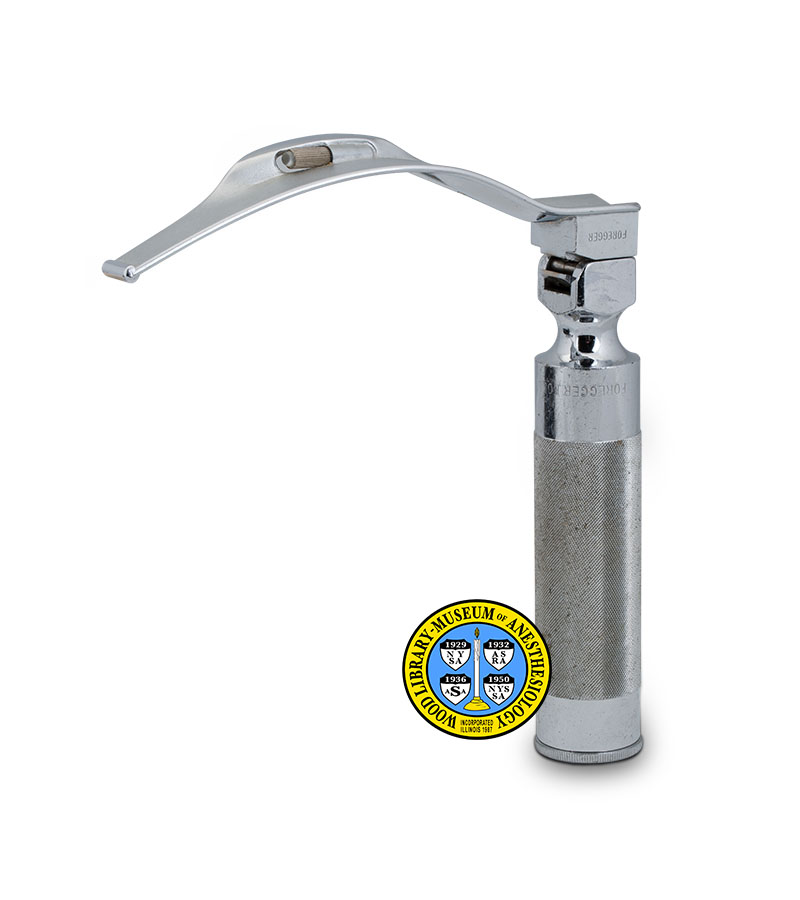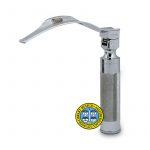Bizzarri-Giuffrida Laryngoscope
Anesthesiologists are responsible for maintaining the patient's respiration during surgery. One of the tools they may use for this is a laryngoscope, which helps them to insert a breathing tube through the patient's larynx (voice-box) and into the trachea (wind pipe.) Intubation is most often done after the patient has been sedated, reducing the body's gag reflex; but prior sedation is not always possible. Two New York physicians, Dante V. Bizzarri, M.D. and Joseph G. Giuffrida, M.D., introduced their new laryngoscope blade in 1958. It is a modification of the popular Macintosh blade.
Conditions such as protruding teeth, receding jaw, enlarged neck or tongue, and anterior larynx (one positioned far back in the throat) can make intubation a challenge. The Bizzarri-Giuffrida blade removes the vertical flange of the Macintosh, making it easier to intubate patients who present a difficult airway. The new blade's low silhouette also reduced the chances of damaging the patient's teeth, and made it easier to intubate awake patients. The example shown here was made by the original manufacturer, Foregger Company, between 1958 and 1962. The blade is also called a "Flange-less Macintosh", and is produced today by several anesthesia equipment manufacturers.
Catalog Record: Bizzarri-Giuffrida Laryngoscope Bizzarri-Giuffrida laryngoscope
Access Key: apny
Accession No.: 2004-03-04-1 B
Title: [Bizzarri-Guiffrida laryngoscope blade] / [designed by Dante V. Bizzarri and Joseph G. Giuffrida].
Author: Bizzarri, Dante V.
Author: Giuffrida, Joseph G.
Corporate Author: Foregger Company.
Publisher: New York : Foregger Company ; [between 1958 and 1962?].
Physical Description: 1 laryngoscope blade : metals, glass or plastic ; 5 x 16 x 2.5 cm.
Subject: Airway Management – instrumentation.
Subject: Intubation, Intratracheal – instrumentation.
Subject: Laryngoscopes – battery-powered.
Subject: Laryngoscopes – curved blades.
Note Type: General
Notes: The first year in the date range is the date of introduction. The second year in the date range is based on the last year that it appeared in the manufacturer’s catalogs.
The object is described from user’s point of view.
Note Type: General
Notes: In their 1965 article on intubation the authors state: “we have previously reported that aspiration can be prevented by placing a large-bore, cuffed tube into the esophagus”, and cite their 1955 publication on pulmonary function in the American Journal of Surgery.
Note Type: With
Notes: Married to a Foregger handle, Accession number 2007-10-26-3 K 3, for purposes of photography. Both the blade and handle are of the Foregger Folding Scope type. The underside of the hub of the blade has a notch that enables the blade to lock onto a bar in the hub of the handle. When it is in the locked position, pushing firmly down on the blade causes it to pivot downward on this bar, folding the blade against the handle for more compact storage. This design allows the components to be interchangeable.
Note Type: Citation
Notes: American Society of Anesthesiologists Archives. Archives. Located at the Wood Library-Museum of Anesthesiology, Schaumburg, Illinois.
Note Type: Citation
Notes: Bizzarri DV, Giuffrida JG. Improved laryngoscope blade designed for ease of manipulation and reduction of trauma. Anesth Analg. July-August, 1958;37(4):231-232.
Note Type: Citation
Notes: Bizzarri D, Giuffrido JG, Fierro F, and Latteri F. Preventing aspiration during anesthesia by esophageal intubation. Anes Analg. May-June, 1965;44(3):365-372.
Note Type: Citation
Notes: Dorsch, JA, Dorsch SE. Understanding Anesthesia Equipment: Construction, Care and Complications. Baltimore: Williams & Wilkins Company, 1975: 233, 236.
Note Type: Citation
Notes: Foregger Company. Catalog 15: Anesthesia And Respiration Appliances. New York: Foregger Company, 1958:134.
Note Type: Citation
Notes: Foregger Company. Catalog 16: Apparatus for Anesthesia Oxygen and Extracorporeal Circulation. New York: Foregger Company, 1960:45.
Note Type: Citation
Notes: Foregger Company. Catalog 17: Anesthesia Apparatus. New York: Foregger Company, 1962:42.
Note Type: Citation
Notes: Hull Anesthesia, Inc. website. http://www.hullanesthesia.com/p/161/laryngoscope-blade-conventional-flange-less-mac-bizzarri-giuffrida. Accessed March 10, 2017.
Note Type: Citation
Notes: McIntyre JWR. Laryngoscope design and the difficult adult tracheal intubation. Canadian J Anesth. January, 1989;36(1):94-98.
Note Type: Citation
Notes: Mercury Medical website. http://mercurymed.com/catalogs/RDR_Laryngoscopes.pdf. Accessed March 10, 2017.
Note Type: Citation
Notes: SunMed website. http://www.sun-med.com/product/detail/flangeless-macintosh-american-profile-blade. Accessed March 10, 2017.
Note Type: Physical Description
Notes: One laryngoscope blade; The blade measures approximately 5 x 16 x 2.5 centimeters; For approximately the first 6 centimeters of its length, measuring from the hub, the lower side of the blade is convex; This groove is most pronounced at the hub; The conduit carrying the connection to the light bulb runs for most of its length on the upper side of the blade, while the bulb itself emerges on the lower side; The tip of the blade is finished with a smooth, rounded bar; The left side of the hub is marked “BIZZARRI (new line) GIUFFRIDA (new line) 4”; The right side of the hub is marked “FOREGGER”; The bottom of the hub is marked “Patent Pending”.
Note Type: Reproduction
Notes: Photographed by Mr. Steve Donisch, November 15, 2016.
Note Type: Acquisition
Notes: Gift of Dr. and Mrs. James T. Roberts. Gift facilitated by Elliott V. Miller, M.D.
Note Type: Historical
Notes: Anesthesiologists are responsible for maintaining the patient’s respiration during surgery. One of the tools they may use for this is a laryngoscope, which helps them to insert a breathing tube through the patient’s larynx (voice-box) and into the trachea (wind pipe.) This is most often done after the patient has been sedated, reducing the body’s gag reflex; but that is not always possible. Two New York physicians, Dante V. Bizzarri, M.D. and Joseph G. Giuffrida, M.D., introduced their new laryngoscope blade in 1958. Three years previously, they had collaborated on the design of an esophageal tube. They were also co-authors of over a dozen scientific papers. Each was a member of the American Society of Anesthesiologists for nearly 50 years.
The Bizzarri and Giuffrida blade is based on the Macintosh blade, which had been introduced more than a decade earlier and continues to be one of the most widely used today. Their modification removes the vertical flange from the Macintosh, making it easier to intubate patients who present a difficult airway. Conditions such as protruding teeth, receding jaw, enlarged neck or tongue, and anterior larynx (one positioned far back in the throat) can make intubation a challenge. The low silhouette of the Bizzarri-Giuffrida blade can help anesthesiologists also reduced the chances of damaging the patient’s teeth, and made it easier to intubate awake patients. Originally made by the Foregger Company, it is made today by several anesthesia equipment manufacturers. The blade is also called a “Flange-less Macintosh”.
Note Type: Publication
Notes: Giuffrida JG, Bizzarri DV. The anesthetic management of patients with altered pulmonary function. Am J Surg. October, 1955;90(4):653-659.
Note Type: Exhibition
Notes: Selected for the WLM website.


